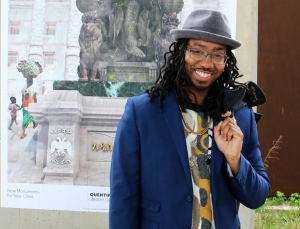Quentin VerCetty Lindsay is an award-winning multidisciplinary visual griot (storyteller) and arts educator who is currently working on his Masters degree in Art Education at Concordia University with a focus on teaching Afrofuturism in underserved communities.
As an artist, Lindsay's work explores ideas around the Afrotopia as it relates to safe spaces for people of colour by utilizing the visual motifs of Afro-Carribean Carnival. He also explores concepts around racial representation, public art, monuments as well as the use of semiotics and Surrealism to tell meta-narratives about society and politics.
Lindsay's art has been featured in numerous media outlets and publications in various countries such as Japan, Haiti, Peru, Ghana, Australia, United Arab Emirates, and France.
Afrofuturism as an Arts Movement: Black Fantasy, Science & Speculative Fiction in Visual Arts from 2009 - 2019
2019 EAHR Researcher: Quentin VerCetty Lindsay

In 2016, his mission for artivism (using art as a tool for social change) led him to launch the Canadian chapter of the Black Speculative Arts Movement (BSAMCanada), an organization that gives a platform for artistic engagement through partnerships and projects, as well as event and content productions. Since its conception, it has continued to spread across the nation. Through his work, Lindsay hopes to engage minds, inspire hearts, and dutifully challenge others to help make the world a better place not only for today but for many tomorrows to come.
Introduction
Afrofuturism as an Arts Movement: Black Fantasy, Science & Speculative Fiction in Visual Arts from 2009 - 2019
Reseacher: Quentin VerCetty Lindsay
Residency Co-ordinator: Renata Critton
Supervising Librarian: John Latour
In the summer of 2019, Quentin VerCetty Lindsay produced an annotated bibliography that analyzes Afrofuturism as an evolving concept within social, cultural and artistic contexts of the 21st century. In keeping with the objective of the EAHR residency, Lindsay's work examines an unrepresented area of research in Ethnocultural art history and aims to diversify Academia at Concordia University. For his bibliography, the author and artist pays special attention to cultural producers and productions from across Canada.
All hyperlinked resources are either available for consultation in the Concordia Library, or listed in WorldCat. Sections included in this annotated bibliography include:
- Books
- Catalogues
- Articles
- Journals
- Biographies of Canadian Afrofuturists
- Contemporary exhibitions
As added visual components to his research, Lindsay has prepared online and virtual exhibitions of portraits of several Afrofuturists referred to in his annotated bibliography.
Artist's statement
Drawing parallels between Afrofuturism and Afro-Caribbean carnival, this series is presented in a multimedia format to explore how both practices are about the celebration of culture, history, resilience and continuity. Among different West African cultural traditions, the masquerader dresses in costume, plays and dances as a conduit of ancestral spirits conjured to share a message for the future. Each illustration represents an individual who has made significant contributions within the artistic movement of Afrofuturism in Canada and globally. They are depicted as frontline masqueraders whose elaborate headdresses and face paint cross-reference the Afro-Caribbean carnival masquerader (who celebrates history and the future) and the continental African masqueraders (whose role is to share a message about tomorrow with today's generation).
The illustrations complement digitally sculpted statues that allegorically represent the different fields of artistic research for which each person is known. These categories include curation; visual arts and installation; photography and film; literature and performance arts. The statues are conceptual tributes that celebrate individuals for their work, and what they've contributed to Afrofuturism as an art movement. Each statue has a ceremonial African masquerader mask that corresponds to one of these categories.
The statue representing the visual arts is wearing the Iyoba Idia ivory mask of the Edo people from Benin and Nigeria. This mask is used for noble and royal family events. It is a celebration of feminine power, and the wearer offers blessings. The mask itself represents the presence of ancestors. It relates to the visual arts in the way that artists create narratives that can be seen as blessings.
Literature is personified with the Krobo Mask from Eastern Ghana. It is traditionally worn during a celebration ceremony that follows a rite of passage. The processes of reading and research are like rites of passage in that they have a starting point, a period of transformative experience, and an end point.
The Film and Photography statues utilize the Kifwebe mask of the Songye people of the Democratic Republic of Congo. It is usually worn during funeral processions or the birth of a child of royal or noble descent. Here, a connection is made between the mask and the Afrofuturist filmmaker and photographer who create new worlds and realities that give birth to new ideas. Through their work, they allude to our own death and to the limits of Blackness and africentricity in the future.
Curatorial practices are represented by a steampunk version of the Walu mask of the Dogon people of Mali. It is a mask of the ancestors and is often worn during ceremonies when kinfolk are gathered for important proclamations. In a related way, curators occupy a role in which they are constantly evaluating and gathering experiences.
Performance art is paired with the twin-faced Puni-Lumbo of the Gabon people. It represents feminine energy, beauty, divintiy, fertility and duality. This mask is worn by sacred persons who wear them for select occasions. They bring blessings to the people of the village. They heal, and grant postive energy that will provide financial or agricultural prosperity. The mask is connected to performance art as Afrofuturist performers offer a space for healing, reflection and inspiration. Performers possess a dual nature, who they are on stage is different from who they are off stage.
Explore the annotated bibliography [PDF - 2.2 MB]
Visit the online exhibition [PDF - 1.84 MB]
Visit the virtual exhibition

